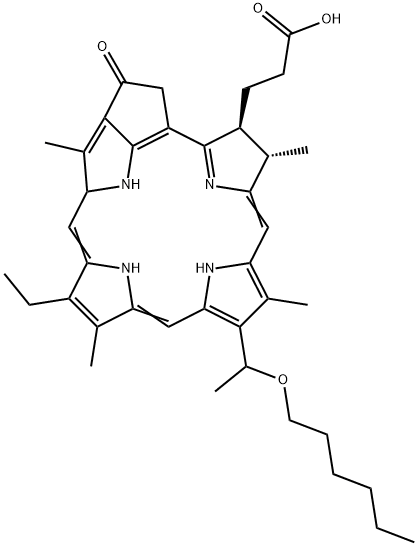149402-51-7
 149402-51-7 結(jié)構(gòu)式
149402-51-7 結(jié)構(gòu)式
基本信息
Photochlor
Photochlor (HTTP)
Photochlor (HPPH)
3-Devinyl-3-(1'-hexyloxy)ethylpyropheophorbide A
2-(1-hexyloxyethyl)-2-devinyl pyropheophorbide-a
14-Ethyl-9-(1-(hexyloxy)ethyl)-4,8,13,18-tetramethyl-20-oxo-4-phorbine propanoic acid
14-Ethyl-9-(1-(hexyloxy)ethyl)-4,8,13,18-tetramethyl-20-oxo-3-phorbine propanoic acid
(3S,4S)-14-Ethyl-9-[1-(hexyloxy)ethyl]-4,8,13,18-tetramethyl-20-oxo-3-phorbinepropanoic acid
3-Phorbinepropanoic acid, 14-ethyl-9-[1-(hexyloxy)ethyl]-4,8,13,18 -tetramethyl-20-oxo-, (3S,4S)-
物理化學(xué)性質(zhì)
常見問題列表
Fluorescence image of 4T1 cells incubated with 0.49 μg/mL GO-PEG, 1 μM HPPH (free HPPH) or equivalent amount of GO-PEG-HPPH (1 μM HPPH and 0.49 μg/mL GO-PEG) after 24 h. The cellular uptake of GO-PEG-HPPH and HPPH is investigated with 4T1 murine mammary cancer cells. The cells are incubated with GO-PEG-HPPH and free HPPH at equivalent HPPH concentration (1 μM) for 24 h and then observed with a confocal microscope. Cells treated with GO-PEG-HHPH shows stronger fluorescence signal than those treated with free HPPH. In fact, the fluorescence of HPPH is rather weak.
Tumors are treated with an immune-enhancing PDT regimen followed by a tumor-controlling PDT regimen can leads to enhancement of anti-tumor immunity, while retaining effective control of primary tumor growth. To test this hypothesis, a combination treatment regimen is devised in which Colo26-HA tumor-bearing BALB/c mice are treated with a HPPH-PDT regimen known to lead to enhanced anti-tumor immunity (0.4 μmoles/kg HPPH followed 18 h later by illumination with 665 nm light for a total dose of 48 J/cm 2 ). Following illumination, mice are rested for 9 days; on the ninth day, mice are injected with HPPH. On day 10 following the first treatment, tumors are treated with a tumor control treatment regimen (illumination with 665 nm light for a total dose of 132 J/cm 2 given).